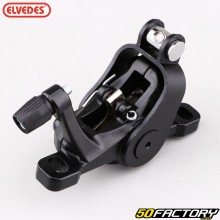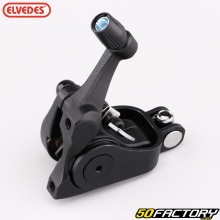 Front brake caliper
Front brake caliper
 Front brake caliper
Front brake caliper
- STOCK EXHAUSTED31€90
- IN STOCK138€10
-
-
-
- IN STOCK69€10
- IN STOCK74€10
Everything you need to know about the front brake caliper for gravel and cyclocross
The role of this equipment
Front brake calipers are essential components of any gravel or cyclo bike's braking system.cross. They help control speed and ensure safe and efficient stopping. When actuated, brake calipers press the brake pads against the rotor or rim, creating the friction needed to slow or stop the bike. A good front brake caliper ensures optimum stopping power and precise modulation, which is crucial for the safety and performance of the rider.
Specifics for gravel and cyclocross
Gravel and cyclo bikescross are designed to tackle varied terrain, from paved roads to dirt trails. Par Therefore, front brake calipers for these types of bikes must be robust and reliable in harsh conditions. They must offer high stopping power and excellent modulation to allow precise control on steep descents and tight corners. In addition, they must be resistant to water, mud and debris to ensure consistent performance whatever the conditions.
The different types
On disk
Disc brake calipers are becoming increasingly popular on gravel and cyclo bikes.cross because of their superior stopping power and consistent performance in wet or muddy conditions. They use metal discs mounted on the wheel hubs, and calipers press pads against these discs to create the necessary friction. Disc brakes can be hydraulic or mechanical. Hydraulic systems offer more precise modulation and greater stopping power, while mechanical systems are easier to maintain and adjust.
On skates
Rim brakes, also called rim brakes, are more traditional and use brake pads that press against the wheel rim to slow or stop the bike. While they are generally less powerful than disc brakes, they may be sufficient for riders who primarily ride on less demanding terrain. They are also lighter and easier to maintain. However, their performance may be affected byar wet or muddy conditions, and they can cause premature rim wear.
Choosing the right brake calipers for your gravel or mopedcross
Depending on the type of bike
The choice of front brake caliper largely depends on the type of bike you own. For gravel bikes, which are often used on varied terrain, disc brakes are generally recommended due to their stopping power and reliability in difficult conditions. For cyclo bikescross, who often have to face mixed terrain races, disc brakes also offer advantages in terms of performance and control. However, some cyclists prefer rim brakes for their lightness and simplicity.
Depending on the type of braking desired
The type of braking you prefer is also a key factor in choosing a front brake caliper. Hydraulic disc brakes offer the best modulation and stopping power, but they can be more expensive and require more maintenance. Mechanical disc brakes are a good alternative for those looking for a compromise between performance and ease of maintenance. Rim brakes, while less powerful, may be sufficient for riders who primarily ride on less demanding terrain and prefer a simpler braking system.
Depending on compatibility
It is crucial to check the compatibility of the front brake caliper with the braking system of your gravel or cyclo bike.cross. Make sure the caliper is compatible with the brake type (disc or pad) and the diameter of the disc or rim of your bike. Also, check that the caliper is compatible with the brake levers and brake hoses or cables of your bike. Proper installation is essential to ensure optimal performance and maximum safety.
Installation
Preparing the fork
Before installing a new front brake caliper on a gravel or mopedcross, it is important to prepare your bike's fork. Thoroughly clean the area where the caliper will be mounted to remove any dirt, grease or debris. Also check that the fork fasteners are in good condition and do not show any signs of wear or damage. If necessary, replace the screws or fasteners to ensure a secure installation.
Assembly
Front brake caliper installation varies depending on the type of brake you are using. For disc brakes, start withar Mount the disc to the front wheel hub, then secure the caliper to the fork using the screws provided. Ensure the caliper is properly aligned with the disc to avoid any rubbing or imbalance. For rim brakes, secure the caliper to the fork by aligning the brake pads with the wheel rim. Tighten all screws and fasteners securely.
Setting
Proper adjustment is essential to ensure optimum performance and maximum safety. For disc brakes, adjust the caliper position so that it is centered par to the disc. Use the adjustment screws to adjust the distance between the brake pads and the disc. For rim brakes, adjust the position of the brake pads so that they are parallel to the rim and contact the rim evenly. Test the brakes to ensure that the brakes are working properly and make any necessary adjustments.
Care instructions
Cleaning
Regular maintenance is essential to maintain the performance of your gravel or moped's front brake calipers.cross. Clean the calipers and brake pads after each ride to remove dirt, mud and debris. Use a clean cloth and a brake cleaner to avoid contaminating the pads or rotor. Regular cleaning helps prevent premature wear and ensures consistent performance.
Brake pad replacement
Brake pads wear over time and need to be replaced regularly to ensure optimum stopping power. Check the thickness of the brake pads and replace them if they are worn down to less than 1 mm. To replace the brake pads, remove the brake caliper and remove the worn pads. Install the new pads, ensuring they are correctly positioned and secured. Reassemble the brake caliper and test the brakes to ensure everything is working properly.
Regular inspection for signs of wear
Regularly inspect the front brake calipers on your gravel or mopedcross for signs of wear or damage. Check fasteners, screws and other parts for damage. Replace any worn parts to ensure optimum performance and maximum safety. Regular inspection helps prevent brake problems before they become serious.












































